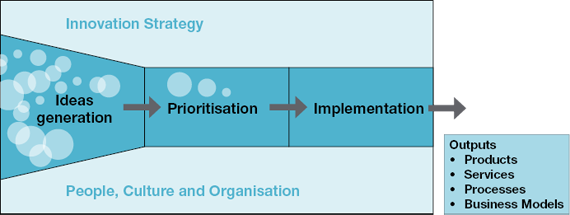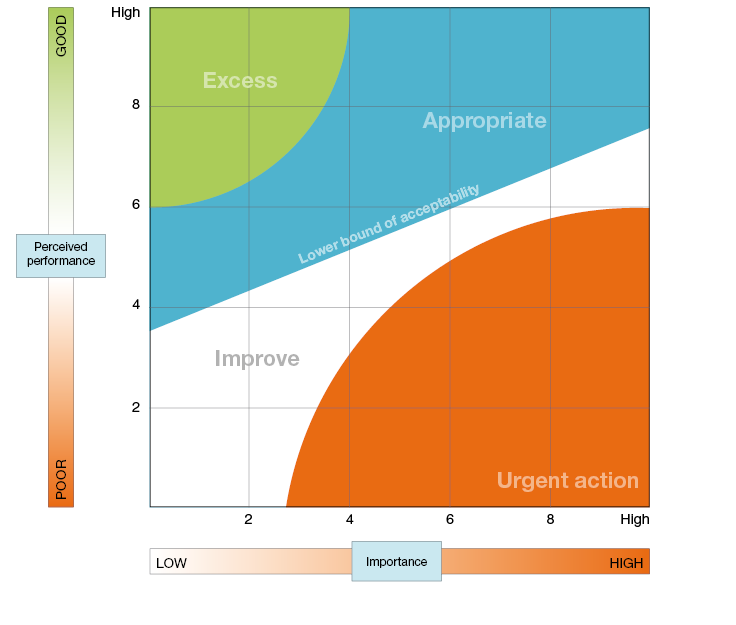 Innovation Audit
Innovation Audit
Introduction
An innovation audit is a way to understand how effective an organisation is at managing innovation. Individual employees are asked to anonymously give their opinions on different aspects of innovation management, such as the way ideas are generated. The main questions are structured around the Pentathlon Framework, which was developed by Professor Keith Goffin at Cranfield School of Management. The Pentathlon Framework classifies innovation into outputs (such as products, services, processes, and business models) and five aspects of innovation management: strategy; ideas generation; prioritisation; implementation; and people, culture and organisation. This is illustrated below:

Mapping
Please use the scales below to...
Rate your perception for each question between "not at all" (0) and "very much so"(10)
Then, rate each question in terms of importance to your organisation
All of your answers should be your opinions of the whole organisation
+A. Innovation strategy section
Our top management meet specifically to define innovation policy and to support innovation investment decisions.
Our main innovation strategy is clear (for example, first-to-market or fast follower).
We have a clear/specific definition of innovation that is shared throughout the business.
We actively monitor our operating environment to identify key trends and market drivers (for example demographics, legislation, changing needs, new technology, etc.).
Our innovation strategy integrates all five areas of innovation management (ideas, prioritisation, implementation, people and strategy)
What should top management do to make the innovation strategy clearer and more effective?
+B. Ideas section
The general climate within all of our departments and functions is supportive of the process of generating ideas.
We take the opportunity to learn from and share experiences with other organisations ("open innovation").
We use structured problem solving approaches (such as brainstorming, TRIZ, scenario development, etc.).
We actively research, identify and capture customers' stated and latent (hidden) needs.
Within our industry we are perceived to be a creative organisation
What should be done to improve the pipeline of ideas generation in our organisation?
+C. Prioritisation section
We have a specific system (as opposed to ad-hoc arrangements) for screening and evaluating ideas in the organisation.
Our portfolio prioritisation process clearly links the choice of projects to our innovation strategy.
We use both financial and scoring methods effectively and efficiently to evaluate our innovation projects.
We have a clear and shared understanding of innovation risk - this allows us to objectively analyze projects.
Our current portfolio is balanced (i.e. projects align with innovation strategy, they maximise value, and make the most efficient use of resources).
What should be done to ensure the right projects are prioritised by our organisation?
+D. Implementation section
We have a systematic new product or new service development process. The steps are integrated and activities take place in parallel with each other.
We are able to ensure that customer and end user input is used throughout the process.
We ensure that sufficient capacity is available in R&D, manufacturing, suppliers and support functions to allow fast and effective product development.
We have a long-term (business) champion for each new product,new services, process and business model.
Our record of new products and services is satisfactory when compared with our main competitors.
What should be done to improve the way our organisation develops new products, new services, processes and business models?
+E. People and organisation section
Management actively creates and sustains a culture of innovation.
Our mission statement mentions 'creativity', 'innovation' or both as being part of the corporate ethos.
Our employees' innovative and entrepreneurial behaviour is encouraged, recognised and/or rewarded.
We set aside budget and actively encourage training for staff in innovation-related activities.
We have a budget set aside for "blue sky" innovation projects - and/or we have a dedicated team working on innovation.
What should be done to improve the "culture of innovation" in our organisation?
+F. Innovation output section
New products and/or new services generate a significant amount of our total revenues.
We have introduced one or more new business models to the market in the last three years.
Our products and services are made more competitive through our process innovations.
We are recognised in our markets to be a leading innovator.
We are achieving significant growth through innovation.
What should be done to increase innovation output in our organisation?
Calculate
Print

A
B
C
D
E
F
- Innovation strategy: to what extent is there a clear, effective and communicated innovation strategy?
- Idea generation: to what extent is there a positive, collaborative approach to generating customer focused ideas?
- Prioritisation: to what extent are the most appropriate ideas selected for implementation?
- Implementation: to what extent are ideas quickly and successfully implemented?
- People and organisation: to what extent is there a culture of innovation?
- Output: to what extent are the number of new products and services developed sufficient?
 Innovation Audit
Innovation Audit
